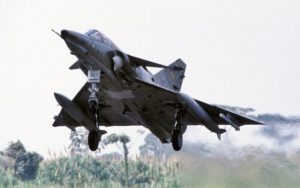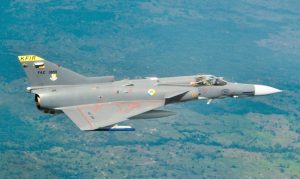Kfir: Israel’s Air Force Had 1 Fighter Plane No Country Wanted to Battle

By Maya Carlin
The Israeli Air Force’s Kfir combat aircraft, a brainchild of necessity and innovation, emerged from the shadows of the French-designed Dassault Mirage 5. In the aftermath of the Six Day War and the Yom Kippur War, Israel’s reliance on French aircraft laid the groundwork for the development of a homegrown fighter capable of superior performance.
The Kfir, developed to counteract the advanced Soviet-designed aircraft of Israel’s adversaries, featured a General Electric J79 turbojet engine, marking a significant upgrade over the Mirage’s original powerplant. With a top speed of 1,520 mph, a combat range of 477 miles, and a service ceiling of 58,010 feet, the Kfir was armed to the teeth with Rafael-designed cannons and an assortment of missiles, making it a formidable “bomb truck.” Entering service in the mid-1970s, the Kfir initially took a central role in the Israeli Air Force.
However, the introduction of American-made F-15 Eagles soon shifted its status. Despite being overshadowed by newer fighters, the Kfir saw action in Lebanon in the 1980s and has since been operated by several foreign militaries, showcasing Israel’s indomitable spirit in aircraft innovation.
The Israeli Air Force’s Kfir combat aircraft was derived from the French-designed Dassault Mirage 5. In the immediate years following its founding, the Jewish state relied heavily on the French platform. In fact, Israel was perhaps the most prolific operator of the Mirage III outside of the French Air Force. This robust aircraft contributed to Israel’s victory against Jordan, Egypt and Syria during the Six Day War of 1967.
The platform also earned its combat-proven service record for its role in the 1973 Yom Kippur War. France and Israel shared close relations around this period and the Mirage IIIC specifically was tailored to fulfil the distinct defense needs of the Jewish state.
While the fighter was the mainstay of the IAF for many years, Israeli officials sought out a longer-range platform for ground-attack missions. The IAI Kfir would satisfy this need.
Until the arrival of the American-made Douglas A-4 Skyhawk and McDonnell Douglas F-4 Phantom II, the IAF depended heavily on the Mirage IICJ through the 1960’s.

Notably, this platform represented the first Mach-2.0 (times the speed of sound) airframe procured by Israel at the time. Israeli officials soon prompted French manufacturer Dassault to begin designing a subsequent Mirage 5 variant. As a modified version of the Mirage IIIC, the new platform retained many similarities.
sophisticated platforms, the IAF needed a superior jet. Israeli engineers weighed incorporating two different engines into the new Kfir airframe- the General Electric J79 turbojet and the Rolls-Royce Spey turbo-fan.
Since the U.S. already licensed Israel to produce the J79 engine for the Douglas F-4 Phantom II, the IAF selected this powerplant. The J79 provided a stronger thrust and afterburning thrust than the original French Atar 09 used to power the Mirage.
The Kfir jet’s maximum speed was 1,520 miles per hour. Its combat range was 477 miles, service ceiling 58,010 feet and rate of climb nearly 46,000 feet per minute. In terms of armament, the Kfir platform was equipped with a pair of Rafael-designed 30mm DEFA 533 cannons with 140 rounds each, and an array of unguided air-to-ground rockets.
Additionally, the airframe could sport an assortment of missiles, including the AIM-9 Sidewinder, Shafrir AAM, Shrike ARM and AGM-65 Maverick. With a payload of over 6 tons, the Kfir was quite the bomb truck.
The first Kfirs entered service with the IAF in the mid-1970’s, assigned to the 101st “First Fighter” Squadron. While this platform was designed to remain the air superiority platform for Israel for many years, the arrival of the American-made F-15 Eagle altered this timeline. By 1976, the first Eagles procured by Israel arrived in the country and quickly took over as the IAF’s preferred platform.
The Jewish state still used the Kfir jets in combat down the line, including in Lebanon later in the decade. When Israel invaded southern Lebanon in 1982 during Operation Peace for Galilee, the F-15 Eagle and F-16 Fighting Falcon were already in place as the IAF’s top fighters. The Kfirs were left to carry out unescorted strike missiles during this conflict.
The IAF’s Kfir fleet began to be relegated to retirement by the late 1990s. However, a few foreign customers, including Ecuador, Sri Lanka, and Columbia, still operate this Israeli platform. (The National Interest)
============
For More News or To Give Us Reports Join Our WhatsApp Group With This Link: https://chat.whatsapp.com/CdPVxGOPHCI5Kd4ALZduZ7 ….